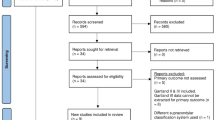Abstract
Background
The purpose of this scoping review was to examine the nature and quality of research regarding paediatric supracondylar humerus (SCH) fractures in low and lower middle-income countries (LICs).
Methods
We searched PubMed, Embase, Web of Science, and African Journals Online on January 9, 2018, for studies of SCH fractures in LICs. Studies were categorized by geographic region, Gartland classification of included patients, and study design. We evaluated each study’s methodology and conclusions.
Results
Out of 1805 results, we analyzed 105 studies, most of which included type 3 fractures only (66%). Many were conducted in South Asia (58%) and assessed treatment outcomes (78%). Most of the studies had level IV evidence (67%). Common limitations of research were small sample size (12%) and inadequate follow-up (6%). Epidemiological studies concluded that SCH fractures are more common among male children, are usually secondary to falls, and rarely present with nerve injuries. Most therapeutic studies reported outcomes of surgery (91%). Thirteen studies concluded that all-lateral versus cross-pinning techniques have similar outcomes. Seven studies reported preference for closed reduction over open reduction, when intra-operative fluoroscopy was available. Most common outcome measures were Flynn criteria (77%) and range of motion (53%). None of the papers looked at treatment costs.
Conclusions
Our data show a predominance of small level IV studies from LICs, with few studies of higher level of evidence. Many studies examined controversies with surgical technique, similar to studies performed in high-income countries. Few studies examined non-operative treatment, which is commonly the predominant treatment available for patients in LICs. Further investigation of common treatment modalities and outcomes for SCH fractures in LICs is needed.


Similar content being viewed by others
References
Cheng JC, Ng BK, Ying SY et al (1999) A 10-year study of the changes in the pattern and treatment of 6,493 fractures. J Pediatr Orthop 19:344–350
Anjum R, Sharma V, Jindal R, Singh TP, Rathee N (2017) Epidemiologic pattern of paediatric supracondylar fractures of humerus in a teaching hospital of rural India: a prospective study of 263 cases. Chin J Traumatol 20(3):158–160
Abzug JM, Herman MJ (2012) Management of supracondylar humerus fractures in children: current concepts. JAAOS 20(2):69–77. https://doi.org/10.5435/JAAOS-20-02-069
Yeomans D, Graham SM, Mkandawire NC, Harrison WJ, Perry DC (2018) Conservative management of displaced paediatric supracondylar fractures: a systematic review. Trop Dr 48(4):359–365
Dharmadevan SV, Ghosh S, Chaudhuri A et al (2015) Management of displaced supracondylar fracture of the humerus in children. Saudi J Sports Med 15:193–198
Spiegel DA, Shrestha OP, Rajbhandary T, Bijukachhe B, Sitoula P, Banskota B, Banskota A (2010) Epidemiology of surgical admissions to a children’s disability hospital in Nepal. World J Surg 34(5):954–962
Rethlefsen M, Koffel J, Kirtley S, Waffenschmidt S, Ayala A (2019) Preferred Reporting Items for Systematic Reviews and Meta-Analysis Search Extension (PRISMA-S). Explanation and elaboration. OSF Preprints 2019
World Bank. http://data.worldbank.org/about/country-and-lending-groups
McGowan J, Sampson M, Salzwedel DM, Cogo E, Foerster V, Lefebvre C (2016) PRESS peer review of electronic search strategies: 2015 guideline statement. J Clin Epidemiol 75:40–46
The Oxford (2011) Levels of Evidence. Oxford Centre for Evidence-Based Medicine. https://www.cebm.net/2016/05/ocebm-levels-of-evidence/
Turgut A, Onvural B, Kazimoglu C et al (2016) How safe is the semi-sterile technique in the percutaneous pinning of supracondylar humerus fracutres? Ulus Travma Acil Cerrahi Derg 22:477–482
Gupta MK, Meena S, Anand S, Arya RK (2017) Closed reduction and percutaneous pinning of supracondylar humerus fractures in children using a semi-sterile technique in a low resource south Asian setting: infection rate and functional outcome. Trop Dr 5:49475517716583
Hussain S, Ahmad M, Muzaffar T (2014) Open reduction and internal fixation for displaced supracondylar fractures of the humerus in children with crossed K-wires via lateral approach. Chin J Traumatol 17:130–135
Bickler SW, Rode H (2002) Surgical services for children in developing countries. Bull World Health Organ 80(10):829–835
Mock C, Cherian M, Juillard C, Donkor P, Bickler S, Jamison D, McQueen K (2010) Developing priorities for addressing surgical conditions globally: furthering the link between surgery and public health policy. World J Surg 34(3):381–385
Saxton AT, Poenaru D, Ozgediz D, Ameh EA, Farmer D, Smith ER, Rice HE (2016) Economic analysis of children’s surgical care in low- and middle-income countries: a systematic review and analysis. PLoS One 11(10):e0165480
Acknowledgments
Thank you to Evans Whitaker, UCSF Library, for peer reviewing our search.
Author information
Authors and Affiliations
Contributions
All authors contributed to the study conception and design. Material preparation, data collection, and analysis were performed by Sravya Challa, Kiran Agarwal-Harding, Paul Levy, Jill Barr-Walker, and Coleen Sabatini. The first draft of the manuscript was written by Sravya Challa and all authors commented on previous versions of the manuscript. All authors read and approved the final manuscript.
Corresponding author
Ethics declarations
Conflict of interest
The authors declare that they have no conflict of interest.
Ethics approval
This study is a systematic review and therefore exempt from IRB review.
Additional information
Publisher’s note
Springer Nature remains neutral with regard to jurisdictional claims in published maps and institutional affiliations.
Rights and permissions
About this article
Cite this article
Challa, S., Agarwal-Harding, K.J., Levy, P. et al. Supracondylar humerus fractures in low- and lower middle-income countries: a scoping review of the current epidemiology, treatment modalities, and outcomes. International Orthopaedics (SICOT) 44, 2443–2448 (2020). https://doi.org/10.1007/s00264-020-04694-8
Received:
Accepted:
Published:
Issue Date:
DOI: https://doi.org/10.1007/s00264-020-04694-8




